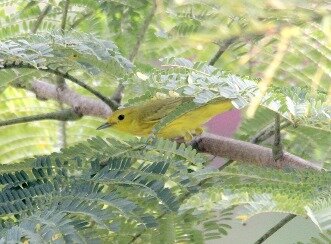American Yellow Warbler
Setophaga aestiva (Gmelin, JF, 1789)
Photo © Kris Webb
STATUS
Canada south to Mexico. Polytypic.
OVERVIEW
Species not admitted nationally during the period covered (BOU 1971).
NOT PROVEN
0). 1860 Sussex Appledram, shot, early October.
(West Sussex Gazette; Eds., Field 6th Oct., 1860: 283).
[Not in BOU, 1971].
History In an Editorial (1860) in The Field of 6th Oct., Vol. XVI. p. 283, he says: 'On Saturday last, Mr. George, bird fancier and taxidermist, shot at Appledram a finch of rare beauty, and probably never before seen in these parts. Mr. George observed the bird the day previous among a large flock of Greenfinches, and finding little chance of taking it alive, he used his gun as soon as he succeeded in getting within range. Mr. George showed the bird to several ornithologists, who were unable to name its genus. It is of a beautiful yellow, very similar to a Canary; but the shape of its beak and general symmetry leaves no doubt as to the species. It is a male bird, and was singing merrily when first seen. Mr. George has manipulated on his prize with much care and skill, and this curious bird may now be seen, among many other rare specimens, at his residence in Westgate (West Sussex Gazette).'
[A correspondent writes: - "The description of the yellow bird lately shot among some finches corresponds with that of what we call the "yellow bird" in Canada (the Mniotilla aestiva). It is by no means unlikely that the bird might be acclimatised here as well as the Canadian rabbit (Lepus americana)".]
0). 1904 Co. Durham Near Axwell Park, picked up, mid-May, photo, now at Great North Museum: Hancock, Newcastle-upon-Tyne.
(W. R. Ogilvie-Grant, Bulletin of the British Ornithologists' Club 15: 46-47; "Hy.S." Field 4th Mar., 1905: 376; W. B. Alexander & R. S. R. Fitter, British Birds 48: 12).
[H. Saunders, British Birds 1: 9-10; Hartert et al., 1912].
History W. R. Ogilvie-Grant, Editor (1905) in the Bulletin of the British Ornithologists' Club, Vol. XV. pp. 46-47, at the 112th Meeting of the Club held on 15th February 1905 at the Restaurant Frascati, London, says: 'Mr. E. Bidwell, through the kindness of Mr. Herbert W. Grace, of Hallgarth, Winlaton-on-Tyne, was enabled to exhibit a specimen of the Yellow Warbler (Dendroica aestiva (Gmel.)) obtained in Great Britain. Mr. Grace had furnished the following particulars: - "This bird was picked up on the Newcastle and Shotley Bridge Road, near Axwell Park, in the county of Durham, in the second or third week of May 1904. It was taken by the lad who found it to Mr. John Walker, a bird-stuffer at Bladon, who set it up and sold it to my game-watcher's son, from whom I bought it. I have my information from Mr. Walker. The bird was quite fresh when he bought it, and had a broken leg, supposed to have been caused by flying against a telegraph-wire"....A discussion followed in which several members took part. Mr. Rothschild thought it quite possible, taking into consideration its migratory habits, that the bird might have received an "assisted passage", but Mr. Howard Saunders was of opinion that it had probably escaped from a cage. Mr. Seth-Smith said that, so far as he was aware, no species of Dendroica had ever been brought to this country in captivity, but Dr. Hartert observed that in Curacao a closely allied species, D. rufopileata, was frequently kept as a cage bird. Finally, Dr. Sclater said that he saw no reason why the bird should not reach England as an accidental autumn-visitor and he pointed out that the distance between northern South America and the northern parts of North America was not greater than the distance between South America and England, and that birds blown out of their course might easily reach our shores.'
"Hy.S." (1905) in The Field of 4th Mar., Vol. CV. p. 376, quotes from the above. Howard Saunders (1907) in British Birds, Vol. I, pp. 9-10, under 'Additions to the List of British Birds since 1899', placing the record in square brackets, says: 'A specimen of the American Yellow Warbler, Dendroica aestiva, was exhibited by Mr. E. Bidwell (Bull. B.O.C., XV. p. 46), and stated to have been picked up near Axwell Park, co. Durham, in May, 1904. In a discussion, Dr. Sclater said "that he saw no reason why the bird should not reach England as an accidental autumn visitor", but it will he remembered that this occurrence was in May. As I decline to believe that a Warbler can cross more than three thousand miles of ocean without food or human aid, I do not add it to the British List.'
W. B. Alexander & R. S. R. Fitter (1955) in British Birds, Vol. XLVIII. p. 12, say: 'This specimen of the eastern race (D. p. aestiva) now has a good claim to be regarded as the first European record of this species, and not to be an escape, as the authors of the Handlist suggested.'
